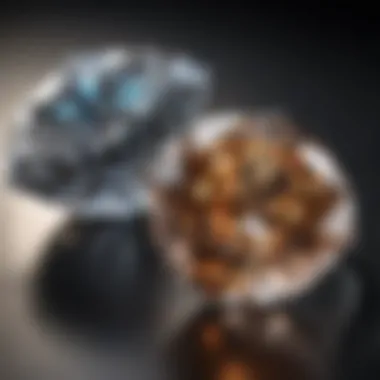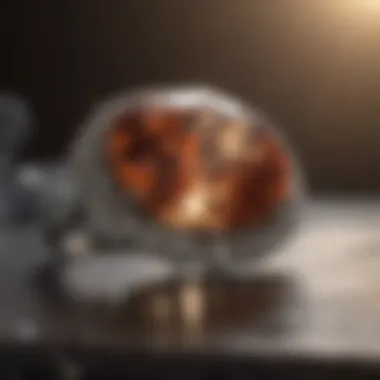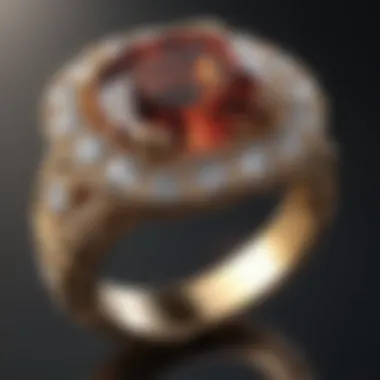Assessing Diamond Ring Quality: A Comprehensive Guide


Intro
In the realm of diamonds, the Four Cs—Carat, Cut, Color, and Clarity—play a critical role in determining quality. The significance of certification cannot be overlooked, as it ensures that the diamond adheres to recognized grading standards. Additionally, ethical sourcing has emerged as a paramount concern for many buyers, influencing both personal values and market dynamics.
As we explore these facets, we delve into the intricate world of gemstones. Understanding the fundamental properties of diamonds, along with the broader classification of gemstones, helps to clarify what sets one diamond apart from another. This foundational knowledge is essential for anyone considering a purchase in the diamond market. Let's start by examining the world of gemstones in detail.
Foreword to Diamond Quality Assessment
Understanding diamond quality is a fundamental aspect for anyone looking to purchase a diamond ring. The process of assessing the quality involves various elements that influence not only the beauty of the diamond but also its value. The quality assessment serves multiple purposes, making it essential for both casual buyers and seasoned collectors. This knowledge helps individuals make informed decisions, ensuring they invest in a diamond that meets their aesthetic and financial expectations.
Purpose of This Guide
The guide aims to demystify the complexities associated with diamond quality assessment. It will outline key criteria, notably the Four Cs: Carat weight, Cut, Color, and Clarity. These components serve as the foundation for evaluating diamonds. Each section of this article will delve into these aspects, providing detailed insights and practical tips. Moreover, this guide will discuss certification programs, highlighting their importance in verifying authenticity. By the end of this guide, readers will have a clearer understanding of what constitutes a high-quality diamond ring.
Importance of Selecting a Quality Diamond
Opting for a quality diamond is critical, especially given that a diamond ring often represents significant personal value. The right diamond can symbolize commitment, achievement, or even personal style. When selecting a diamond, quality directly affects not only appearance but also future resale value. A well-chosen diamond can last a lifetime, making it an enduring possession.
The clarity of the diamond influences how it sparkles and reflects light. The cut determines its brilliance while color grading affects its visual appeal. Therefore, understanding these elements is not just advantageous; it is crucial for anyone seeking a diamond that encapsulates their needs and preferences.
"A diamond's value is often determined as much by its quality as its emotional significance."
When evaluating a diamond, potential buyers should consider the ring's overall style, the setting, and personal resonance with the piece. Quality assessments help buyers avoid pitfalls and make choices that align with their vision and intentions.
Understanding the Four Cs
The Four Cs—carat weight, cut quality, color grading, and clarity scale—are crucial elements in determining the quality of diamond rings. Their importance lies not only in assessing value but also in understanding how each aspect contributes to the overall appearance and desirability of a diamond. By mastering the Four Cs, gemmologists, collectors, and enthusiasts can make informed decisions that align with their preferences and financial considerations.
Carat Weight
Carat weight refers to the size of the diamond, with one carat being equal to 0.2 grams. Carat weight plays a significant role in the diamond's perceived value, as larger diamonds are typically rarer and more sought after. However, carat weight alone does not determine a diamond's quality. For instance, the appearance of a diamond can vary greatly depending on its cut, making it important to consider the cut alongside the carat.
When purchasing a diamond, think about the balance between carat weight and your budget. Investing in a diamond just over a full carat can often yield better value than aiming for a larger stone. Additionally, two diamonds of the same carat weight can have different prices based on their cut and other factors.
Cut Quality
Cut quality is paramount in assessing a diamond's brilliance and sparkle. It refers to how well the diamond has been shaped and polished, which affects how light interacts with it. A well-cut diamond can appear larger and more brilliant compared to a poorly cut stone of the same carat weight.
The cut grade ranges from excellent to poor, impacting not just aesthetic qualities but also the stone's overall value. Consider the proportions, symmetry, and polish of the stone, as each of these factors contributes to its beauty. A skilled jeweler can provide insights on the cut quality, ensuring you choose a diamond with optimal light performance.
Color Grading
Color grading assesses the absence of color in a diamond, with the best quality being entirely colorless. Diamonds are graded on a scale from D (colorless) to Z (light yellow or brown). The less color a diamond possesses, the more valuable it tends to be. However, personal preference plays a role in this choice. Some individuals may prefer the warmth of a faintly colored diamond, while others may seek the purity of a colorless stone.
When evaluating color, keep in mind that subtle differences can dramatically affect value. For this reason, it is beneficial to compare diamonds side by side in various lighting conditions.
Clarity Scale
Clarity measures the presence of internal or external flaws, known as inclusions and blemishes, respectively. A diamond's clarity grade can range from Flawless (no visible flaws) to Included (flaws visible to the naked eye). While diamonds with higher clarity grades are more expensive, many collectors find that inclusions are often microscopic and do not detract significantly from the stone's beauty.
Evaluating clarity often requires expertise, making it beneficial to refer to certification documents from reputable gemological laboratories. Knowing the clarity of your diamond can guide you in making well-informed purchases, aligning your choices with aesthetic and financial goals.
The Four Cs remain foundational in both valuing and selecting diamond rings, acting as a common language between sellers and buyers.


Certification: Verifying Authenticity
In the world of diamond rings, certification is a crucial factor that cannot be overlooked. It serves as a tangible validation of a diamond's qualities, ensuring that buyers acquire a gemstone that meets their expectations. A certified diamond indicates that it has undergone rigorous evaluation by an independent gemological laboratory.
Certification provides several significant benefits. Firstly, it offers assurance regarding the quality of the diamond based on the Four Cs: Carat, Cut, Color, and Clarity. Each of these attributes influences the overall value and appearance of the stone. Buyers can have confidence that they are receiving an evaluated product as advertised.
Secondly, certified diamonds typically have higher resale value. When it comes time to sell or upgrade, potential buyers often prefer stones with certification. This established credibility can lead to quicker transactions and potentially higher selling prices. Moreover, a diamond without certification may raise questions about its authenticity and the integrity of its grading.
Overall, certification acts as a safeguard for consumers. It empowers them to make informed decisions and protects their investment in the long run.
Role of Gemological Laboratories
Gemological laboratories play a pivotal role in the certification process. These institutions specialize in the analysis and grading of gemstones, employing experts with extensive knowledge and training in gemology. A laboratory conducts a thorough examination of the diamond using advanced tools and methodologies.
Key aspects analyzed by gemological laboratories include:
- Carat weight: Measuring the size of the diamond.
- Cut quality: Assessing how well the diamond has been cut, which affects brilliance and sparkle.
- Color grading: Determining the presence of color in the diamond, which can impact its desirability.
- Clarity evaluation: Examining inclusions and blemishes to assign a clarity grade.
The findings are compiled into detailed reports, which serve as a reference for both buyers and sellers. Not only do these reports confirm the diamond's characteristics, but they also provide objective assessments that are widely recognized in the industry.
Understanding Diamond Reports
A diamond report, often referred to as a grading report or certificate, is a document accompanying a certified diamond. It outlines the stone's unique characteristics as assessed by the laboratory. Understanding the contents of this report is essential for those investing in a diamond ring.
Typically, a diamond report includes:
- Identification details: Includes the shape and measurements of the diamond.
- Grading of the Four Cs: Description of carat weight, color grade, clarity grade, and cut grade.
- Additional features: Overview of any fluorescence or treatments applied to the diamond.
- Unique identifiers: Inclusion of a laser inscription number or other identifiers.
"A diamond report enhances transparency in the diamond market. It holds sellers accountable for the authenticity of their offerings."
Reading and understanding a diamond report empowers buyers. It allows them to appreciate the value of what they are purchasing. Moreover, it provides clarity and assurance, knowing their investment is backed by a certified evaluation.
The Impact of Diamond Shape on Perception and Value
Understanding diamond shape is crucial when assessing the overall quality and appeal of diamond rings. The shape of a diamond does not only impact its aesthetics; it also influences perception and market value. Different shapes can evoke diverse emotional responses and hold distinct cultural significances. For gemstone enthusiasts, collectors, and jewelry designers, knowing these influences aids in informed selections.
Popular Diamond Shapes
When discussing diamond shapes, there are several well-known configurations that stand out. Each shape comes with its unique characteristics:
- Round Cut: Often considered the most popular shape, it's known for its brilliance and desirability.
- Princess Cut: A favorite among modern brides, square in shape and known for its sharp lines.
- Emerald Cut: Recognized for its long lines and step cuts, offering a vintage or classic feel.
- Oval Cut: Combines the beauty of the round with a unique elongated silhouette.
- Pear Cut: Resembles a teardrop, often praised for its romantic appearance.
- Cushion Cut: A square shape with rounded corners, known for its vintage feel and soft appearance.
Each of these shapes appeals to certain preferences, which can affect buyer decisions and market trends.
How Shape Influences Quality Perception
Diamond shape significantly influences how consumers perceive quality. For instance, the round cut is often associated with higher quality and craftsmanship because it has a well-established cut standard that offers superior brilliance. In contrast, other shapes, like the marquise or heart, may not be viewed with the same level of prestige.
The aesthetic presentation of various shapes can lead to differing perceptions of size and weight as well. A well-cut oval diamond can appear larger than its carat weight suggests, positively impacting buyer perception.
"The shape of a diamond not only affects its beauty but also its market demand and resale value."
Understanding these distinctions helps potential buyers navigate the diamond market more effectively.
Recognizing that preferences for shape can be influenced by current trends aids in predicting diamond ring valuations. This awareness can lead to more informed buying decisions and enhance overall satisfaction with the purchase.


Setting Styles and Their Importance
A well-chosen setting can highlight the diamond’s qualities, making it look more lively and sparkly. Understanding the interaction between the ring's setting and the diamond can aid buyers in making informed decisions. This consideration is essential not only for personal satisfaction but also for investment value; a superb diamond may lose its desirability if placed in a poorly designed or mismatched setting.
Key benefits of setting styles include:
- Enhancement of Beauty: Different settings can accentuate the color and clarity of a diamond.
- Protection: The right setting can protect the stone from impact and wear.
- Style Expression: The setting can communicate personal style and preferences in jewelry design.
In summary, the setting style is not merely a background for the diamond; it is an integral part of the ring's overall quality and appeal. Therefore, the choice of setting should reflect both the diamond's characteristics and the wearer's taste.
Common Setting Types
There are several common types of settings, each with distinct features:
- Prong Setting: This is perhaps the most popular. It consists of small metal claws that hold the diamond securely while allowing maximum light to penetrate the stone, enhancing its sparkle.
- Bezel Setting: In this setting, the diamond is surrounded by a metal rim. This style offers more protection and a modern look but can reduce the amount of light entering the stone.
- Channel Setting: This involves setting smaller diamonds into a metal channel. It creates a sleek, continuous look and is often used for wedding bands.
- Tension Setting: A more contemporary style, in which the diamond is held in place by the tension of the metal band, giving the impression that it is floating.
Each type offers different aesthetic and practical benefits. Choosing a suitable setting is crucial for both beauty and functionality, while also reflecting the wearer’s personal style.
Effect of Setting on Gemstone Security
The security of a diamond in its setting cannot be overlooked. The choice of setting directly impacts how well the stone is held in place and protected from accidents, dirt, and damage. A well-designed setting can ensure that the diamond remains secure during everyday activities.
Some important considerations regarding the effect of setting on gemstone security include:
- Prong Wear: In prong settings, the claws may wear down over time and become loose, increasing the risk of losing the diamond. It’s essential to occasionally check and maintain the strength of the prongs.
- Depth of Setting: A deeper setting can help keep the diamond secure, minimizing the chance of it snagging on clothing or being knocked out of place.
- Material Strength: The choice of metal also matters. Stronger metals, like platinum, provide better security for the diamond compared to softer metals.
Ultimately, selecting the right setting will not only enhance the visual appeal of the diamond ring but also ensure the security of the gemstone, providing peace of mind to the wearer.
Evaluating Diamond Ring Styles
In the realm of diamond jewelry, the style of the ring plays a critical role in both its aesthetic appeal and its overall value. Evaluating diamond ring styles is not merely about personal taste but involves a deeper understanding of design elements, host settings, and how each style showcases the diamond itself. This section aims to illuminate key aspects of evaluating ring styles, illuminating benefits and practical considerations for both collectors and enthusiasts.
Classic vs. Modern Styles
Classic styles often reflect tried and tested designs that have stood the test of time. These include solitaires, three-stone settings, and pavé rings. The simplicity and elegance of a classic ring is its biggest appeal, often allowing the diamond to take center stage without distraction. In contrast, modern styles might incorporate unique settings, unexpected shapes, and mixed metals. These designs push boundaries and offer innovative ways to present diamonds, appealing to those who prefer contemporary expressions of beauty.
When evaluating classic styles, look for quality craftsmanship and timeless elements. A well-executed solitair offers a clean, streamlined look that draws the eye to the diamond. Modern styles may require more careful consideration of balance and harmony between the diamond and the setting. It is essential to ensure that the diamond is securely held and visibly striking, without being overshadowed by intricate designs.
Trends in Diamond Rings
Staying abreast of current trends is vital for anyone interested in diamond rings. Over the past few years, customization has gained significant momentum. More buyers are looking for unique designs that reflect their personalities. This can involve everything from selecting unique gemstone combinations to opting for environmentally friendly materials.
Among the trending styles, colored gemstones paired with diamonds have become fashionable, often adding a celestial or vintage flair to traditional settings. Vintage-inspired styles, alongside art deco influences, are also capturing the imagination of many collectors.
"The diamond ring market remains dynamic, constantly evolving with individual tastes and societal trends."
Another trend gaining traction is ethically-sourced diamonds. This shift ties into a more substantial global movement towards responsible consumption. Knowing a diamond's origin can enhance its value both materially and sentimentally. Collectors are now more than ever aware of the implications behind their choices, making ethical considerations a significant factor in contemporary diamond ring evaluation.
Ethical Sourcing of Diamonds
Ethical sourcing of diamonds has gained heightened importance in recent years. This reflects a growing awareness among consumers about the origins of the products they purchase. In the realm of diamond rings, ensuring ethical practices not only aligns with personal values but also impacts the overall value and desirability of the diamond itself. This section explores key factors of ethical sourcing, including its implications for diamond quality and the broader industry landscape.
Understanding Conflict-Free Diamonds


Conflict-free diamonds are stones that have been sourced without funding violence or human rights violations. These diamonds typically come from regions where trade does not exploit workers or finance armed conflicts. The Kimberley Process, established in 2003, aims to reduce the trade of conflict diamonds by ensuring that all diamonds are certified conflict-free. However, the process has faced criticism over its effectiveness. Consumers are encouraged to research not just the mining practices but also the socio-political contexts where diamonds are harvested.
A diamond's ethical status can significantly influence its market value. Many buyers now prioritize diamonds with proven conflict-free certifications, boosting demand for responsibly sourced stones. Consequently, jewelers displaying transparent supply chains often attract more discerning customers.
Responsible Mining Practices
Responsible mining practices encompass a range of methods designed to minimize environmental damage and support local communities. This includes ensuring fair wages, safe working conditions, and investment in community development. Mining companies are increasingly adopting responsible practices in response to consumer demand and regulatory pressures.
Some specific practices include:
- Rehabilitation of Mining Sites: After extraction, companies may take steps to restore ecosystems.
- Community Engagement Initiatives: Collaborating with local populations to understand their needs and address social issues.
- Environmental Safeguards: Implementing techniques to reduce pollution and resource depletion.
These practices not only enhance the ethical profile of the diamonds but also contribute to the sustainability of the industry. Buyers can play a role in promoting responsible mining by choosing diamonds from companies that prioritize ethical sourcing.
"By choosing ethically sourced diamonds, we are not just buying jewelry; we are investing in a future that values human dignity and environmental health."
Maintenance and Care of Diamond Rings
Taking care of diamond rings is crucial to preserving their beauty and value over time. Just like any other fine jewelry, diamond rings require regular maintenance to ensure they remain sparkling and undamaged. The care you provide can directly influence both attractiveness and longevity. Being diligent about maintenance prevents the risk of dirt, oils, and scratches from degrading the quality.
The significance of maintaining a diamond ring cannot be overstated. When cared for correctly, a diamond's brilliance is maximized, making it a timeless piece that can be passed down through generations. It's not solely about aesthetics; regular care also involves checking the setting and ensuring that the diamond remains secure. This attention to detail protects an investment that often holds sentimental value.
Cleaning Techniques
Cleanliness is essential for diamond rings. Regular cleaning can restore the ring's original shine. There are several effective techniques to achieve this.
- Mild Soap and Water: Mix a few drops of mild dish soap with warm water. Soak the ring for 20 to 30 minutes, then gently scrub with a soft toothbrush. Rinse thoroughly and dry with a lint-free cloth.
- Commercial Jewelry Cleaner: Use a professional cleaner specially designed for jewelry. Follow the instructions on the product to avoid any damage.
- Ultrasonic Cleaners: These machines can be effective but must be used with caution. Ensure your setting can withstand such cleaning before using this method.
It's wise to avoid harsh chemicals or abrasive materials. They can harm the finish and damage settings. Regular cleaning can help maintain a diamond's brilliant appearance even after years.
Storage Solutions
Proper storage is another integral part of maintaining your diamond ring. Thoughtful storage practices help prevent scratches and tangling with other jewelry.
- Separate Compartments: Store diamond rings in compartments or dedicated slots in a jewelry box. This prevents them from knocking against other pieces.
- Use a soft pouch or case: For travel or short-term storage, use a cushioned pouch to shield it from potential scratches and dust.
- Keep away from humidity and extreme temperatures: Store the ring in a cool, dry place to prevent any adverse reactions.
"Proper maintenance and care can significantly extend the life and beauty of your diamond rings."
In essence, a commitment to maintenance and care will not only uphold the sparkle of diamond rings but also their structural integrity. By implementing consistent cleaning routines and proper storage methods, owners can ensure that their rings remain in top condition for years to come.
Closure: Making Informed Decisions
Making informed decisions is a crucial part of selecting a diamond ring. The process involves understanding the various components that determine quality, value, and overall aesthetics. Knowing the significance of the Four Cs—Carat, Cut, Color, and Clarity—plays a vital role in your purchase. Each of these elements contributes uniquely to the beauty and worth of a diamond, and their intricate balance is essential for a discerning choice.
Moreover, certification from reputable gemological laboratories offers reassurance regarding the authenticity and documented grading of your diamond. Such certifications serve as a guide in the complex market of diamonds, enhancing your confidence in the decision made.
Ethical considerations have become increasingly important. Engaging with conflict-free diamonds and supporting responsible mining practices not only adds value to your purchase but aligns with moral standards many consumers expect today.
Ultimately, making informed decisions extends beyond just the physical attributes of a diamond but includes understanding market dynamics, ethical sourcing, and maintenance considerations. Doing thorough research and having clarity on what you seek can significantly enhance your overall experience and satisfaction with your chosen piece.
Summary of Key Points
- Understanding the Four Cs: The significant criteria for diamond assessment, affecting both its physical beauty and value.
- Certification: The importance of gemological reports for verification of diamond quality and characteristics.
- Ethics in Sourcing: The growing relevance of purchasing conflict-free diamonds and supporting ethical practices.
- Consumer Knowledge: The role of informed decision-making in enhancing the buying experience and overall satisfaction.
Final Thoughts on Diamond Selection
To that end, whether you are a collector, a designer, or simply seeking the perfect piece for a loved one, take your time to explore all information available. Be persistent in your research. Informed decision-making will not only lead to better enjoyment of your diamond but will also empower you as a buyer within an often complex marketplace.
"The journey of selecting a quality diamond can be as rewarding as the moment you present it."
The more you understand about diamonds, the better you will appreciate their value. Be aware, be informed, and choose wisely.



